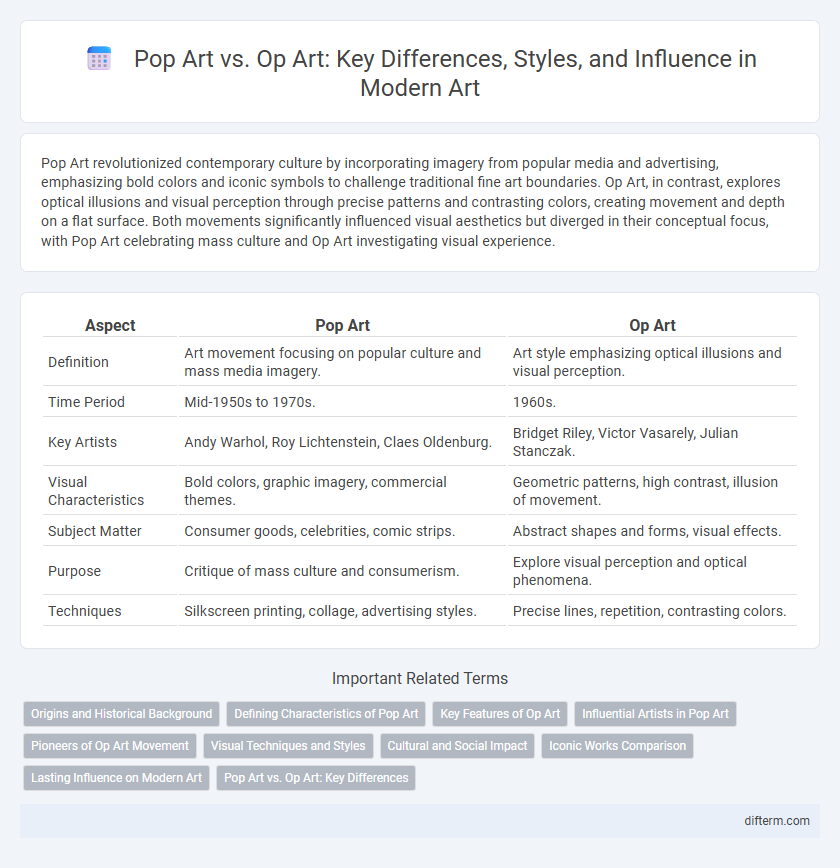Pop Art revolutionized contemporary culture by incorporating imagery from popular media and advertising, emphasizing bold colors and iconic symbols to challenge traditional fine art boundaries. Op Art, in contrast, explores optical illusions and visual perception through precise patterns and contrasting colors, creating movement and depth on a flat surface. Both movements significantly influenced visual aesthetics but diverged in their conceptual focus, with Pop Art celebrating mass culture and Op Art investigating visual experience.
Table of Comparison
| Aspect | Pop Art | Op Art |
|---|---|---|
| Definition | Art movement focusing on popular culture and mass media imagery. | Art style emphasizing optical illusions and visual perception. |
| Time Period | Mid-1950s to 1970s. | 1960s. |
| Key Artists | Andy Warhol, Roy Lichtenstein, Claes Oldenburg. | Bridget Riley, Victor Vasarely, Julian Stanczak. |
| Visual Characteristics | Bold colors, graphic imagery, commercial themes. | Geometric patterns, high contrast, illusion of movement. |
| Subject Matter | Consumer goods, celebrities, comic strips. | Abstract shapes and forms, visual effects. |
| Purpose | Critique of mass culture and consumerism. | Explore visual perception and optical phenomena. |
| Techniques | Silkscreen printing, collage, advertising styles. | Precise lines, repetition, contrasting colors. |
Origins and Historical Background
Pop Art emerged in the 1950s and 1960s, originating in Britain and the United States as a response to the post-war consumer culture and mass media influence. Op Art developed in the early 1960s, rooted in the exploration of optical illusions and visual perception, heavily influenced by artists like Bridget Riley and Victor Vasarely. Both movements reflect the evolving artistic experimentation during the mid-20th century but diverge in their thematic focus and stylistic execution.
Defining Characteristics of Pop Art
Pop Art is characterized by its bold use of vibrant colors, iconic imagery from mass media and popular culture, and a focus on everyday consumer goods and celebrities. It often employs techniques such as collage, silkscreen printing, and repetition to challenge traditional fine art by blurring the boundaries between high art and commercial art. Key figures like Andy Warhol and Roy Lichtenstein exemplify Pop Art's celebration of popular culture and commentary on consumerism.
Key Features of Op Art
Op Art, emerging in the 1960s, is characterized by its use of optical illusions, geometric shapes, and precise color contrasts to create dynamic visual effects that seem to move or vibrate. Unlike Pop Art, which emphasizes popular culture and bold imagery, Op Art focuses on stimulating the viewer's perception through intricate patterns and spatial ambiguity. Artists like Bridget Riley and Victor Vasarely pioneered this style, exploiting visual phenomena such as moire patterns and afterimages to engage and challenge the observer's vision.
Influential Artists in Pop Art
Pop Art emerged in the 1950s and 1960s, with influential artists like Andy Warhol, Roy Lichtenstein, and Claes Oldenburg redefining visual culture through bold colors and commercial imagery. These artists challenged traditional art by incorporating mass media, advertising, and popular icons, which contrasted with Op Art's focus on optical illusions and abstract patterns pioneered by Bridget Riley and Victor Vasarely. Pop Art's legacy lies in its ability to critique consumerism and elevate everyday objects to the status of fine art.
Pioneers of Op Art Movement
Victor Vasarely and Bridget Riley are considered pioneering figures of the Op Art movement, known for their innovative use of optical illusions and geometric patterns that create dynamic visual effects. While Pop Art, led by artists like Andy Warhol and Roy Lichtenstein, emphasizes bold imagery from popular culture, Op Art focuses on perceptual effects and abstract designs that engage viewers' vision directly. Op Art's foundational role in modern art highlights its distinct approach to exploring visual perception through precise spatial arrangements and contrasting colors.
Visual Techniques and Styles
Pop Art employs bold colors, recognizable imagery from popular culture, and clear, graphic lines to create visually striking and accessible compositions. Op Art uses precise geometric patterns, optical illusions, and contrasting black-and-white or vibrant color schemes to generate movement and depth, engaging viewers' perception. While Pop Art often evokes cultural commentary through figurative representation, Op Art prioritizes abstract visual effects that challenge the viewer's visual experience.
Cultural and Social Impact
Pop Art challenged traditional art by incorporating imagery from popular culture and mass media, making art more accessible and reflecting consumer society's values. Op Art, with its focus on optical illusions and perception, influenced the visual culture by engaging audiences in interactive experiences that questioned reality and visual interpretation. Both movements significantly shaped the 1960s cultural landscape, highlighting shifts in societal attitudes toward art, technology, and mass communication.
Iconic Works Comparison
Pop Art's iconic works, such as Andy Warhol's "Marilyn Diptych," emphasize bold colors and popular culture imagery, creating a visual impact that comments on consumerism and mass media. In contrast, Op Art's masterpieces, like Bridget Riley's "Movement in Squares," utilize precise geometric patterns and optical illusions to engage viewers' perception and create dynamic visual movement. These differing approaches highlight Pop Art's cultural critique versus Op Art's exploration of visual sensation and perception.
Lasting Influence on Modern Art
Pop Art's lasting influence on modern art is evident through its bold use of commercial imagery and vibrant colors, which challenged traditional artistic boundaries and paved the way for contemporary visual culture. Op Art's contribution lies in its exploration of optical illusions and perceptual effects, inspiring advancements in visual perception studies and interactive art forms. Together, these movements continue to shape modern aesthetics by merging popular culture with innovative visual techniques.
Pop Art vs. Op Art: Key Differences
Pop Art emphasizes bold imagery and cultural icons drawn from mass media and consumerism, using vibrant colors and recognizable symbols to challenge traditional fine art. Op Art, or Optical Art, focuses on creating visual illusions through precise patterns and contrasting colors, manipulating viewers' perception of movement and depth. While Pop Art engages with popular culture and commentary, Op Art is rooted in abstract visual effects and sensory experience.
Pop Art vs Op Art Infographic

 difterm.com
difterm.com